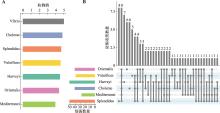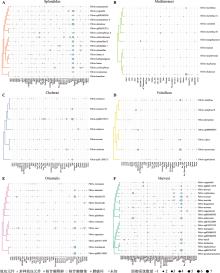Hereditas(Beijing) ›› 2025, Vol. 47 ›› Issue (9): 1057-1068.doi: 10.16288/j.yczz.24-290
• Research Article • Previous Articles
Comprehensive analysis of the composition and distribution of anti-phage defense systems in Vibrio genomes
Xuefeng Xu1,2( ), Xingkun Jin1,2, Yan Shi1,2, Zhe Zhao1,2(
), Xingkun Jin1,2, Yan Shi1,2, Zhe Zhao1,2( )
)
- 1. Jiangsu Province Engineering Research Center for Marine Bio-resources Sustainable Utilization, Hohai University, Nanjing 210024, China
2. Department of Marine Biology, College of Oceanography, Hohai University, Nanjing 210024, China
-
Received:2024-12-02Revised:2025-03-07Online:2025-03-08Published:2025-03-07 -
Contact:Zhe Zhao E-mail:jiayueshisan@gmail.com;zhezhao@hhu.edu.cn -
Supported by:National Natural Science Foundation of China(31872597);National Natural Science Foundation of China(42376119);Jiangsu Agricultural Science and Technology Independent Innovation Fund(CX[23]1007)
Cite this article
Xuefeng Xu, Xingkun Jin, Yan Shi, Zhe Zhao. Comprehensive analysis of the composition and distribution of anti-phage defense systems in Vibrio genomes[J]. Hereditas(Beijing), 2025, 47(9): 1057-1068.
share this article
Add to citation manager EndNote|Reference Manager|ProCite|BibTeX|RefWorks
| [1] | Yan MC, Chen SB, Shan LZ, Xie QL. A critical review: pathogenic Vibrio in maricultural animals. Fish Sci, 2009, 28(8): 475-481. |
| 闫茂仓, 陈少波, 单乐州, 谢起浪. 海水养殖动物致病弧菌的研究进展. 水产科学, 2009, 28(8): 475-481. | |
| [2] | Zheng HY, Yan L, Yang C, Wu YR, Qin JL, Hao TY, Yang DJ, Guo YC, Pei XY, Zhao TY, Cui YJ. Population genomics study of Vibrio alginolyticus. Hereditas(Beijing), 2021, 43(4): 350-361. |
| 郑宏源, 闫琳, 杨超, 武雅蓉, 秦婧靓, 郝彤宇, 杨大进, 郭云昌, 裴晓燕, 赵彤言, 崔玉军. 溶藻弧菌群体基因组学研究. 遗传, 2021, 43(4): 350-361. | |
| [3] |
Baker-Austin C, Oliver JD, Alam M, Ali A, Waldor MK, Qadri F, Martinez-Urtaza J. Vibrio spp. infections. Nat Rev Dis Primers, 2018, 4(1): 8.
pmid: 30002421 |
| [4] |
Erken M, Lutz C, McDougald D. The rise of pathogens: predation as a factor driving the evolution of human pathogens in the environment. Microb Ecol, 2013, 65(4): 860-868.
pmid: 23354181 |
| [5] |
Molina-Quiroz RC, Silva-Valenzuela CA. Interactions of Vibrio phages and their hosts in aquatic environments. Curr Opin Microbiol, 2023, 74: 102308.
pmid: 37062175 |
| [6] |
Faruque SM, Mekalanos JJ. Phage-bacterial interactions in the evolution of toxigenic Vibrio cholerae. Virulence, 2012, 3(7): 556-565.
pmid: 23076327 |
| [7] | Li M, Cheng FY, Gong LY, Xiang H. Systematic discovery of novel prokaryotic defense systems: progress and prospects. Hereditas(Beijing), 2018, 40(4): 259-265. |
| 李明, 程飞跃, 龚路遥, 向华. 微生物新型防御系统的系统性发现与展望. 遗传, 2018, 40(4): 259-265. | |
| [8] |
Rostøl JT, Marraffini L. (Ph)ighting phages: how bacteria resist their parasites. Cell Host Microbe, 2019, 25(2): 184-194.
pmid: 30763533 |
| [9] |
Georjon H, Bernheim A. The highly diverse antiphage defence systems of bacteria. Nat Rev Microbiol, 2023, 21(10): 686-700.
pmid: 37460672 |
| [10] |
Tesson F, Hervé A, Mordret E, Touchon M, d’Humières C, Cury J, Bernheim A. Systematic and quantitative view of the antiviral arsenal of prokaryotes. Nat Commun, 2022, 13(1): 2561.
pmid: 35538097 |
| [11] |
Payne LJ, Meaden S, Mestre MR, Palmer C, Toro N, Fineran PC, Jackson SA. PADLOC: a web server for the identification of antiviral defence systems in microbial genomes. Nucleic Acids Res, 2022, 50(W1): W541-W550.
pmid: 35639517 |
| [12] |
Hendry TA, Dunlap PV. The uncultured luminous symbiont of Anomalops katoptron (Beryciformes: Anomalopidae) represents a new bacterial genus. Mol Phylogenet Evol, 2011, 61(3): 834-843.
pmid: 21864694 |
| [13] |
Costa AR, van den Berg DF, Esser JQ, Muralidharan A, van den Bossche H, Bonilla BE, van der Steen BA, Haagsma AC, Fluit AC, Nobrega FL, Haas PJ, Brouns SJJ. Accumulation of defense systems in phage-resistant strains of Pseudomonas aeruginosa. Sci Adv, 2024, 10(8): eadj0341.
pmid: 38394193 |
| [14] |
Johnson MC, Laderman E, Huiting E, Zhang C, Davidson A, Bondy-Denomy J. Core defense hotspots within Pseudomonas aeruginosa are a consistent and rich source of anti-phage defense systems. Nucleic Acids Res, 2023, 51(10): 4995-5005.
pmid: 37140042 |
| [15] |
Kushwaha SK, Wu Y, Avila HL, Anand A, Sicheritz- Pontén T, Millard A, Marathe SA, Nobrega FL. Comprehensive blueprint of Salmonella genomic plasticity identifies hotspots for pathogenicity genes. PLoS Biol, 2024, 22(8): e3002746.
pmid: 39110680 |
| [16] |
Tal N, Millman A, Stokar-Avihail A, Fedorenko T, Leavitt A, Melamed S, Yirmiya E, Avraham C, Brandis A, Mehlman T, Amitai G, Sorek R. Bacteria deplete deoxynucleotides to defend against bacteriophage infection. Nat Microbiol, 2022, 7(8): 1200-1209.
pmid: 35817891 |
| [17] |
Wein T, Sorek R. Bacterial origins of human cell- autonomous innate immune mechanisms. Nat Rev Immunol, 2022, 22(10): 629-638.
pmid: 35396464 |
| [18] |
Mega R, Kondo N, Nakagawa N, Kuramitsu S, Masui R. Two dNTP triphosphohydrolases from Pseudomonas aeruginosa possess diverse substrate specificities. FEBS J, 2009, 276(12): 3211-3221.
pmid: 19438719 |
| [19] |
Bernheim A, Millman A, Ofir G, Meitav G, Avraham C, Shomar H, Rosenberg MM, Tal N, Melamed S, Amitai G, Sorek R. Prokaryotic viperins produce diverse antiviral molecules. Nature, 2021, 589(7840): 120-124.
pmid: 32937646 |
| [20] |
Makarova KS, Wolf YI, Koonin EV. Comparative genomics of defense systems in archaea and bacteria. Nucleic Acids Res, 2013, 41(8): 4360-4377.
pmid: 23470997 |
| [21] |
Oliveira PH, Touchon M, Rocha EPC. The interplay of restriction-modification systems with mobile genetic elements and their prokaryotic hosts. Nucleic Acids Res, 2014, 42(16): 10618-10631.
pmid: 25120263 |
| [22] |
Matsuzaki S, Inoue T, Tanaka S. Evidence for the existence of a restriction-modification system common to several species of the family Vibrionaceae. FEMS Microbiol Lett, 1992, 94(1-2): 191-194.
pmid: 1521769 |
| [23] |
Barrangou R, Fremaux C, Deveau H, Richards M, Boyaval P, Moineau S, Romero DA, Horvath P. CRISPR provides acquired resistance against viruses in prokaryotes. Science, 2007, 315(5819): 1709-1712.
pmid: 17379808 |
| [24] |
Box AM, McGuffie MJ, O’Hara BJ, Seed KD. Functional analysis of bacteriophage immunity through a type I-E CRISPR-Cas system in Vibrio cholerae and its application in bacteriophage genome engineering. J Bacteriol, 2016, 198(3): 578-590.
pmid: 26598368 |
| [25] |
Jiang CQ, Tanaka M, Nishikawa S, Mino S, Romalde JL, Thompson FL, Gomez-Gil B, Sawabe T. Vibrio Clade 3.0: new Vibrionaceae evolutionary units using genome-based approach. Curr Microbiol, 2021, 79(1): 10.
pmid: 34905112 |
| [26] |
Fan CL, Liu S, Dai WF, He L, Xu HQ, Zhang HY, Xue QG. Characterization of Vibrio mediterranei isolates as causative agents of vibriosis in marine bivalves. Microbiol Spectr, 2023, 11(2): e0492322.
pmid: 36728415 |
| [27] | Wang WJ, Liu HX, Yue HY, Zhao TR, Zhang MM. Genome-wide characterization of 7 strains of Vibrio cholerae isolated from aquatic products. J Food Saf Qual, 2024, 15(19): 314-320. |
| 王伟杰, 刘海霞, 岳航羽, 赵韬然, 张眉眉. 7株水产品来源的霍乱弧菌的全基因组特征分析. 食品安全质量检测学报, 2024, 15(19): 314-320. | |
| [28] |
Lutz C, Erken M, Noorian P, Sun SY, McDougald D. Environmental reservoirs and mechanisms of persistence of Vibrio cholerae. Front Microbiol, 2013, 4: 375.
pmid: 24379807 |
| [29] |
Tan DM, Svenningsen SL, Middelboe M. Quorum sensing determines the choice of antiphage defense strategy in Vibrio anguillarum. mBio, 2015, 6(3): e00627.
pmid: 26081633 |
| [30] | Sun SY, Wu SB, Zhang XQ, Liang CC, Qiao JJ. Advances in quorum-sensing bidirectional interactions between phages and bacteria. Chin Biotechnol, 2024, 44(1): 107-117. |
| 孙舒扬, 吴胜波, 张欣乔, 梁畅畅, 乔建军. 噬菌体与细菌基于群体感应的双向互作. 中国生物工程杂志, 2024, 44(1): 107-117. | |
| [31] |
Reyes-Robles T, Dillard RS, Cairns LS, Silva-Valenzuela CA, Housman M, Ali A, Wright ER, Camilli A. Vibrio cholerae outer membrane vesicles inhibit bacteriophage infection. J Bacteriol, 2018, 200(15): e00792-17.
pmid: 29661863 |
| [32] |
Depardieu F, Didier JP, Bernheim A, Sherlock A, Molina H, Duclos B, Bikard D. A eukaryotic-like serine/threonine kinase protects staphylococci against phages. Cell Host Microbe, 2016, 20(4): 471-481.
pmid: 27667697 |
| [33] |
Doron S, Melamed S, Ofir G, Leavitt A, Lopatina A, Keren M, Amitai G, Sorek R. Systematic discovery of antiphage defense systems in the microbial pangenome. Science, 2018, 359(6379): eaar4120.
pmid: 29371424 |
| [34] |
Hochhauser D, Millman A, Sorek R. The defense island repertoire of the Escherichia coli pan-genome. PLoS Genet, 2023, 19(4): e1010694.
pmid: 37023146 |
| [35] |
Tang DM, Chen YJ, Chen H, Jia TT, Chen Q, Yu YM. Multiple enzymatic activities of a Sir2-HerA system cooperate for anti-phage defense. Mol Cell, 2023, 83(24): 4600-4613.e6.
pmid: 38096825 |
| [36] |
Macdonald E, Wright R, Connolly JPR, Strahl H, Brockhurst M, van Houte S, Blower TR, Palmer T, Mariano G. The novel anti-phage system Shield co-opts an RmuC domain to mediate phage defense across Pseudomonas species. PLoS Genet, 2023, 19(6): e1010784.
pmid: 37276233 |
| [37] |
Barcia-Cruz R, Goudenège D, de Sousa JAM, Piel D, Marbouty M, Rocha EPC, Le Roux F. Phage-inducible chromosomal minimalist islands (PICMIs), a novel family of small marine satellites of virulent phages. Nat Commun, 2024, 15(1): 664.
pmid: 38253718 |
| [38] | Tesson F, Planel R, Egorov AA, Georjon H, Vaysset H, Brancotte B, Néron B, Mordret E, Atkinson GC, Bernheim A, Cury J. A comprehensive resource for exploring antiphage defense: defensefinder webservice, wiki and databases. Peer Community J, 2024, 4: e91. |
| [39] |
Vassallo CN, Doering CR, Littlehale ML, Teodoro GIC, Laub MT. A functional selection reveals previously undetected anti-phage defence systems in the E. coli pangenome. Nat Microbiol, 2022, 7(10): 1568-1579.
pmid: 36123438 |
| [40] |
Bernheim A, Sorek R. The pan-immune system of bacteria: antiviral defence as a community resource. Nat Rev Microbiol, 2020, 18(2): 113-119.
pmid: 31695182 |
| [1] | Jiawen Ma, Xinle Liang. Analysis of structure and function of phage community occurring in the abnormal fermentation of vinegar mash through virome sequencing [J]. Hereditas(Beijing), 2025, 47(4): 489-498. |
| [2] | Liu Jixiang, Lai Siting, Bai Jing, Xu Jin. Il34 rescues metronidazole-induced impairment of spinal cord regeneration in zebrafish central nervous system [J]. Hereditas(Beijing), 2024, 46(6): 478-489. |
| [3] | Xiaojun Yang, Zhenhan Huang, Wei Liu, Wenqing Zhang, Zhibin Huang. Identification and functional characterization of CD209 homologous genes in zebrafish [J]. Hereditas(Beijing), 2024, 46(11): 947-957. |
| [4] | Qingyu Sun, Yang Zhou, Lijuan Du, Mengke Zhang, Jiale Wang, Yuanyuan Ren, Fang Liu. Analysis between macrophage-related genes with prognosis and tumor microenvironment in non-small cell lung cancer [J]. Hereditas(Beijing), 2023, 45(8): 684-699. |
| [5] | Huiyu Chen, Suwen Zhao. Progress on Z genome biosynthetic pathway of bacteriophage [J]. Hereditas(Beijing), 2023, 45(10): 887-903. |
| [6] | Zhilu Fan, Liyan Yang, Na Zhang, Dan Feng, Jing Guo, Chen Chang, Qing Yuan, Yan Cai, Yu Zhang, Wenqiang Wei, Mingrong Wang, Jiajie Hao. NEFL promotes invasion and migration of esophageal squamous carcinoma cells via the EGFR/AKT/S6 pathway [J]. Hereditas(Beijing), 2022, 44(4): 322-334. |
| [7] | Shanshan Wang, Wanyi Zhao, Huixiao Wu, Meng Shu, Jiaxin Yuan, Li Fang, Chao Xu. Research on the variants of FGFR1 and CEP290 genes in idiopathic hypogonadotropin hypogonadism [J]. Hereditas(Beijing), 2022, 44(10): 937-949. |
| [8] | Youhong Chen, Wenhao Yang, Chao Ni. Using esophagus organoid to explore the role of c-Myc in esophageal cancer initiation [J]. Hereditas(Beijing), 2021, 43(6): 601-614. |
| [9] | Chen Xuemei, Wei Yunlin, Ji Xiuling. Research progress of prophages [J]. Hereditas(Beijing), 2021, 43(3): 240-248. |
| [10] | Zhiwei Xu, Yunlin Wei, Xiuling Ji. Progress on phage genomics of Pseudomonas spp. [J]. Hereditas(Beijing), 2020, 42(8): 752-759. |
| [11] | Caijiao Liang, Fanmei Meng, Yuncan Ai. CRISPR/Cas systems in genome engineering of bacteriophages [J]. Hereditas(Beijing), 2018, 40(5): 378-389. |
| [12] | Ming Li,Feiyue Cheng,Luyao Gong,Hua Xiang. Systematic discovery of novel prokaryotic defense systems: progress and prospects [J]. Hereditas(Beijing), 2018, 40(4): 259-265. |
| [13] | Yue Shi,Zhengzheng Xu,Huan Lu,Weimin Ci. Correlation studies of distinct mutational signatures with common cancer pathological subtyping [J]. Hereditas(Beijing), 2018, 40(11): 1033-1038. |
| [14] | Xin Zhou,Weiyun Li,Hongyan Wang. The roles and mechanisms of MST1/2 in the innate immune response [J]. Hereditas(Beijing), 2017, 39(7): 642-649. |
| [15] | Xiaoxu Li, Cheng Liu, Wei Li, Zenglin Zhang, Xiaoming Gao, Hui Zhou, Yongfeng Guo. Genome-wide identification, phylogenetic analysis and expression profiling of the WOX family genes in Solanum lycopersicum [J]. HEREDITAS(Beijing), 2016, 38(5): 444-460. |
| Viewed | ||||||
|
Full text |
|
|||||
|
Abstract |
|
|||||













